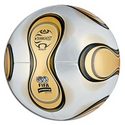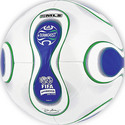 After the keepers from Germany and England complained that the new Teamgeist ball was harder to stop, everyone was expecting that overall match scores would increase. The record high goal count of the opening World Cup match between Germany and Costa Rica sure supported that theory. But is the new ball really going to result in an explosion of goals?
After the keepers from Germany and England complained that the new Teamgeist ball was harder to stop, everyone was expecting that overall match scores would increase. The record high goal count of the opening World Cup match between Germany and Costa Rica sure supported that theory. But is the new ball really going to result in an explosion of goals?
There is no question the new Teamgeist ball has captured the attention of World Cup fans world wide. Even with a small site like mine, Teamgeist is usually responsible for many of my Google referrals (i.e. someone searched for Teamgeist and found my site in the search results). Google Trends doesn’t have 2nd quarter data available yet, so it is hard to tell if there has been an overall spike in searches for it. However, Google’s blogsearch tool shows almost 2,350 blog posts which mention the ball. Clearly adidas has scored a marketing hit with this new ball. But is it going to drastically change the level of scoring in the beautiful game? I’m starting to think it won’t.
 I’m ashamed to admit it, but due to a lack of satellite TV this year, I haven’t seen an MLS match this season. (I’m visiting many ‘establishments’ this month to catch the World Cup – oh the horrors!) So I didn’t realize that they had started using the Teamgeist as part of an overall agreement with adidas for equipment and uniforms. I also hadn’t heard of any MLS keepers complaining about the new ball, but I hadn’t looked very hard. It didn’t take long to find:
I’m ashamed to admit it, but due to a lack of satellite TV this year, I haven’t seen an MLS match this season. (I’m visiting many ‘establishments’ this month to catch the World Cup – oh the horrors!) So I didn’t realize that they had started using the Teamgeist as part of an overall agreement with adidas for equipment and uniforms. I also hadn’t heard of any MLS keepers complaining about the new ball, but I hadn’t looked very hard. It didn’t take long to find:
"It’s a nightmare, an absolute nightmare," D.C. United goalkeeper Troy Perkins said. "There’s going to be a lot of goals when the World Cup starts. But I guess that’s people want to see."
"Technology hasn’t favored goalkeepers, that’s for sure," said New York Red Bulls keeper Tony Meola, who has 100 appearances with the U.S. national team. "It’s lively, it knuckles a lot, especially if it gets anything on it: dirt, sand, water."
The two main complaints have been the surface is slick making it hard to grab and that it moves around a lot (‘knuckles’) on long shots. While I expect there is some truth to this, will it mean keepers will be beat more often or does it mean they’ll simply have to adjust to the flight behavior of the new ball? I’m expecting the latter.
To try and back this up, I grabbed all of the MLS scores for the past 10 weeks and calculated the average number of goals per match (2.85) and the average goal differential (1.19). That doesn’t strike me as completely out of whack (though I don’t have ready access to historical averages to really compare). I was also curious to see if the early weeks had more goal scoring then later ones. Turns out they were about the same.
| Week |
Avg Goals Per Match |
| 1 |
4 |
| 2 |
2.3 |
| 3 |
2.3 |
| 4 |
3 |
| 5 |
2 |
| 6 |
3.4 |
| 7 |
2.29 |
| 8 |
3.33 |
| 9 |
2.8 |
| 10 |
3.13 |
| Overall |
2.85 |
So except for Week 1, there is no major change. It will be interesting to see what the average goals per match are for the World Cup, but based on the first few games (statistically insignificant), we have had 2.4 goals per match. Does that strike anyone else as abnormally high?
The one thing most players and spectators seem to agree on is this ball allows for more accurate long range shots. We’ve seen some 30+ yard rockets so far and I expect we’ll see more. That is what seems to be the most prominent nightmare for keepers. However that is also something they will adjust for – the increased likelihood that players will take long range shots.
I did stumble across an article claiming the ball would be ‘30% more accurate’ I’d love to know how they came up with that! Did they hire Beckham to shoot at a target for hours? The article did contain a VERY interesting tidbit though:
Adidas, the maker of the football, aims to sell more than ten million of these balls over the next couple of months.
TEN MILLION!?!? Those balls are $130 USD! Unless they’re including the replica balls (which are normal stitched balls with the Teamgeist design), that is a stunning number. Might be time to buy some adidas stock! (No I’m not making stock recommendations, though their sales were up 40% last quarter, just sayin…)
Another interesting trivia point:
The 1966 World Cup was the last to feature a ball untainted with logos. For the 1970 World Cup, Adidas introduced the Telstar, with black-and-white pentagons designed to be more visible on black-and-white televisions. In 1930, when the first World Cup took place, Argentina and Uruguay could not agree on which ball to use in the final. So, they played with a ball of Argentine make in the first half and a Uruguayan one in the second.
So that’s where the black and white pentagon pattern came from.
So will we see significantly higher scores in matches? I doubt it – the keepers will adjust (and enjoy having a ready excuse for a bad match!). But I expect we’ll see more and more rockets from far out which is a good thing, even if the keepers stop most of them.
And all this aside, I still want one. Sigh to have disposable income…





January 30th, 2008 at 11:00 am
What was design intended to improve?
January 31st, 2008 at 6:41 am
A number of things. One of the main ones was water retention. Soccer balls are very porous because of the stitching, so they can absorb a fair amount of water on a wet pitch and thus get heavier. With the glued seams, this ball absorbs almost no weight. It is also holds shape better and given the smoother seams, travels through the air better. However, its slick surface gave keepers fits, so the 2nd generation of this ball (the Europass) has a dimpled surface on it like a golf ball.